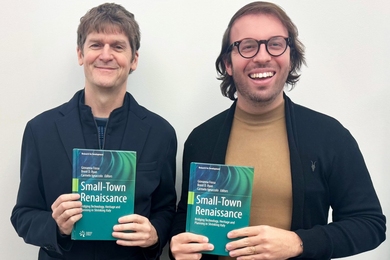William P. Allis, 98, of Cambridge, professor emeritus of physics, died March 5 at Mt. Auburn Hospital in Cambridge after a brief illness. There will be a memorial service for him on Monday, March 22 at 3:30 in the MIT Chapel and a reception at 4:30 in the Compton Room (26-110).
Professor Allis's theoretical research encompassed all aspects of gaseous electronics. He and Professor Sanborn C. Brown were instrumental in establishing MIT's Research Laboratory of Electronics as one of the premier laboratories of its kind.
Professor Allis was one of the co-founders of the American Physical Society's Gaseous Electronics Conference, and after serving as its chairman from 1949-62, he was named honorary chairman in 1966. He also served as assistant secretary general for scientific affairs with NATO from 1962-64.
Since his retirement from MIT in 1967, he traveled extensively as a visiting professor and lecturer. He hosted many MIT faculty members and students at his 200-acre Yonder Farm in Dublin, NH, and continued to ski, climb nearby Mt. Monadnock, chop firewood and bicycle well into his later years.
Professor Allis was born in Menton, France, in 1901, the son of Edward P. Allis Jr., who graduated from MIT in 1870, and Amedine Sgrena. Home-educated, he came to MIT, graduated in 1923 after three years and earned a master of science degree in 1924. His postgraduate studies involved research at the University of Nancy in France, where he received the ScD degree in physics in 1925, Princeton University, the University of Munich and Cambridge University.
His affiliation with MIT continued as a research associate (1925-29) and instructor (1931-34) in physics. He joined the department's faculty in 1934 and was appointed full professor in 1950.
Briefly with MIT's Radiation Laboratory (RadLab), Professor Allis conducted research on magnetron theory, and was then selected to serve as the liaison officer between the Pentagon and RadLab for the duration of World War II. He achieved the rank of lieutenant colonel and, in 1945, was awarded the Legion of Merit.
His honors include fellowship in the American Physical Society and the Physical Society of London, the vice presidency of the American Academy of Arts and Sciences and membership in the American Association for the Advancement of Arts and Sciences and the American Association of Physics Teachers. He also served as consultant to the Los Alamos Scientific Laboratory, as a member of various committees of the National Research Council and visiting professor at Harvard University.
His books include Thermodynamics and Statistical Mechanics (1952); Nuclear Fusion (1960); Waves in Anistropic Plasmas (1962, with Solomon Buchsbaum and Abraham Bers); Electrons, Ions and Waves (1967) and Principles of Laser Plasmas (1976), as well as numerous articles in scientific journals.
Professor Allis once said that the students he educated were his most significant achievement. "Whenever I am travelling in some distant, crowded airport, someone inevitably comes up to me and says, 'Professor Allis, I worked with you!' That has been the most rewarding aspect of being a teacher."
Professor Allis was predeceased by his wife, Nancy Olive (Morison) Allis, and a son, Edward Morison Allis. He is survived by a daughter, Amedine Allis Bella of Peterborough, NH; a son, John Cotton Allis of Belmont; grandsons William Phelps Allis II and Ivan N. Bella; and granddaughters Alyssa N. Bella, Padget G. Allis and Galen Allis. Memorial gifts may be given to the Appalachian Mountain Club and the Gaseous Electronic Conference of the American Physical Society.
A version of this article appeared in the March 10, 1999 issue of MIT Tech Talk (Volume 43, Number 22).





